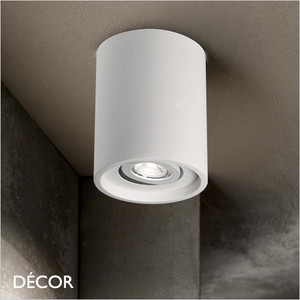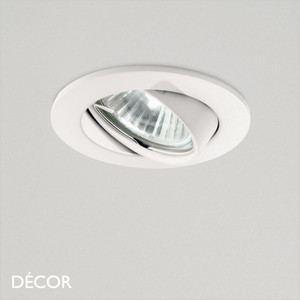
1A1 Ideal Lux - Tower, Round - Paintable White Gypsum Modern Designer Recessed Ceiling Downlight/Spotlight - Stylish Minimalist Design For Any Contemporary Space
PRICE FROM:
€39.00
(€39.00
Inc. VAT)
Contemporary Italian designer recessed downlight that features a cylindrical body that is made of gypsum plaster and so can be easily painted or varnished. The Tower is also available with a rectangular body.
White gypsum
Pastic bayonet for easy installation
IP20
Ø 7 x H 11 cm
GU10 max 1 x 35W
LIGHT BULB REQUIRED:
GU10 LED Spotlight Bulb
Max: 35W. Not included.
A suitable bulbs can be added to your order.
DESIGNED IN DENMARK
For more information about this product please complete the Product Enqury Form
LED lighting has revolutionized the lighting industry. These tiny Light Emitting Diodes (LEDs) produce a huge amount of light without the need for a huge amount of heat. As they don't require heat to make them bright, like traditional incandescent bulbs, they use very little electricity making them very low cost to run. LED lighting is extremely energy-efficient and long-lasting.
Any light can be fitted with an LED light bulb. Some lights contain a pre-fitted LED Module where the light source is already fitted within the light itself. These are named LED because the whole light is LED. These lights are popular because there is no need to purchase an additional bulb.
Lower Energy Bills:
LED lighting draws much less power than traditional lighting. A typical 60W incandescent bulb can be replaced by a 9W LED bulb to give the same level of light meaning that LED lights will save you money on your energy bills. LED lights can be up to 90% more energy-efficient and so more cost-effective than traditional lighting such as incandescent lights. Although more expensive initially, LED bulbs last up to 50 times longer than incandescent bulbs, reducing the need to frequently replace them.
Helping The Environment:
As these bulbs use less power it means that less energy is demanded from power plants and the greenhouse gas emissions are decreased. A longer life span means lower carbon emissions.
HOW TO CHOOSE WHICH LED BULB TO USE
Brightness:
Traditional, incandescent bulbs use many more watts and so demand much more power than the new LEDs for the same brightness. The specification of a light states the maximum traditional incandescent wattage allowed, ie. Max 40W. This number not only refers to the maximum wattage but also to the recommended brightness of the light bulb required. The bulb's wattage only states how much power the light is demanding and not how bright the light is.
The easiest way to compare LED light bulbs with incandescent light bulbs is to look at the amount of brightness each bulb can produce. Lumens (LMs) are used to measure the brightness of a light. The higher the Lumen, the brighter the light will be. Therefore, it is important to consult the Lumens amount when selecting the bulb to achieve the desired level of brightness.
The table below is a guide to show the equivalent bulb wattage for traditional incandescent light bulbs and LED light bulbs and the equivalent Lumens (brightness) produced.
Kelvins (colour temperature - Warm, neutral or cool white light:
As well as differences in brightness (expressed in lumens), LED light bulbs also differ in the 'colour temperature' of the white light that they emit. This is measured in Kelvins (K) and indicates the warmth or coolness of how the light appears and the ambience it creates.
Warm, Neutral or cool - the best colour temperature for your space:
The colour temperature of the light used has a significant effect on the comfort, ambience and the purpose of the space.
White light with a yellow hue (2200K) is very similar to candlelight so it creates an extremely warm ambience and is often used to create a vintage feel.
Warm white light (2500K to 3000K) is relaxing and good for a living room, dining room, bedroom and the general household. This creates a comfortable ambience.
Neutral white light (4000K to 4500K) is used in spaces that require crisp, bright light; a bathroom, kitchen and task lighting. Also, outdoor areas, shops, museums, commercial and healthcare spaces. This bright light is still comfortable for your eyes.
Cool white light (5500K to 6000K) is good for large retail environments, warehouses, utility areas and outdoor floodlights. This light is slightly blue and so very stark making it uncomfortable for a living space.

HOW TO CHOOSE WHAT IP NUMBER TO USE
Every light has an IP Number. This number can usually be found on the tag or packaging. IP stands for Ingress Protection and determines the level that the light has been protected from penetration of liquid or dust etc. The IP has 2 numbers (e.g. IP20). These 2 numbers refer to the level of protection (from dust or liquids) and it is important that you choose lights with the correct rating according to where they are to be positioned. The higher the IP rating the more protected the light is. IP44 is the most common IP rating used in bathroom lighting and for outdoor lighting where there is a degree of shelter. All interior lights are usually rated IP20.
IP FIRST NUMBER
Protection from solids
Protected against foreign objects penetrating the material:
0: Not protected
1: Solid objects larger than 50 mm
2: Solid objects larger than 12 mm
3: Solid objects larger than 2.5 mm
4: Solid objects larger than 1.0 mm
5: Dust protected
6: Dust-proof
IP SECOND NUMBER
Protection from liquids
Protected against water penetrating the material:
0: Not protected
1: Vertically dripping water
2: Vertically dripping water at an inclination of 15? degrees
3: Splashes of water at an angle of up to 60? degrees
4: Splashes of water from any direction
5: Protected against low pressure jet of water
6: Protected against high pressure jet of water
7: Protected against the effects of temporary immersion in 1 metre of water
8: Protected against the effects of temporary immersion beyond 1 metre of water
Any light can be fitted with an LED light bulb. Some lights contain a pre-fitted LED Module where the light source is already fitted within the light itself. These are named LED because the whole light is LED. These lights are popular because there is no need to purchase an additional bulb.
Lower Energy Bills:
LED lighting draws much less power than traditional lighting. A typical 60W incandescent bulb can be replaced by a 9W LED bulb to give the same level of light meaning that LED lights will save you money on your energy bills. LED lights can be up to 90% more energy-efficient and so more cost-effective than traditional lighting such as incandescent lights. Although more expensive initially, LED bulbs last up to 50 times longer than incandescent bulbs, reducing the need to frequently replace them.
Helping The Environment:
As these bulbs use less power it means that less energy is demanded from power plants and the greenhouse gas emissions are decreased. A longer life span means lower carbon emissions.
HOW TO CHOOSE WHICH LED BULB TO USE
Brightness:
Traditional, incandescent bulbs use many more watts and so demand much more power than the new LEDs for the same brightness. The specification of a light states the maximum traditional incandescent wattage allowed, ie. Max 40W. This number not only refers to the maximum wattage but also to the recommended brightness of the light bulb required. The bulb's wattage only states how much power the light is demanding and not how bright the light is.
The easiest way to compare LED light bulbs with incandescent light bulbs is to look at the amount of brightness each bulb can produce. Lumens (LMs) are used to measure the brightness of a light. The higher the Lumen, the brighter the light will be. Therefore, it is important to consult the Lumens amount when selecting the bulb to achieve the desired level of brightness.
The table below is a guide to show the equivalent bulb wattage for traditional incandescent light bulbs and LED light bulbs and the equivalent Lumens (brightness) produced.
| Incandescent Bulbs: | LED Bulbs: | Lumens: |
| 25W | 4W | 220+ |
| 40W | 6W | 400+ |
| 60W | 10W | 700+ |
| 75W | 14W | 900+ |
| 100W | 18W | 1300+ |
Kelvins (colour temperature - Warm, neutral or cool white light:
As well as differences in brightness (expressed in lumens), LED light bulbs also differ in the 'colour temperature' of the white light that they emit. This is measured in Kelvins (K) and indicates the warmth or coolness of how the light appears and the ambience it creates.
Warm, Neutral or cool - the best colour temperature for your space:
The colour temperature of the light used has a significant effect on the comfort, ambience and the purpose of the space.
White light with a yellow hue (2200K) is very similar to candlelight so it creates an extremely warm ambience and is often used to create a vintage feel.
Warm white light (2500K to 3000K) is relaxing and good for a living room, dining room, bedroom and the general household. This creates a comfortable ambience.
Neutral white light (4000K to 4500K) is used in spaces that require crisp, bright light; a bathroom, kitchen and task lighting. Also, outdoor areas, shops, museums, commercial and healthcare spaces. This bright light is still comfortable for your eyes.
Cool white light (5500K to 6000K) is good for large retail environments, warehouses, utility areas and outdoor floodlights. This light is slightly blue and so very stark making it uncomfortable for a living space.

HOW TO CHOOSE WHAT IP NUMBER TO USE
Every light has an IP Number. This number can usually be found on the tag or packaging. IP stands for Ingress Protection and determines the level that the light has been protected from penetration of liquid or dust etc. The IP has 2 numbers (e.g. IP20). These 2 numbers refer to the level of protection (from dust or liquids) and it is important that you choose lights with the correct rating according to where they are to be positioned. The higher the IP rating the more protected the light is. IP44 is the most common IP rating used in bathroom lighting and for outdoor lighting where there is a degree of shelter. All interior lights are usually rated IP20.
IP FIRST NUMBER
Protection from solids
Protected against foreign objects penetrating the material:
0: Not protected
1: Solid objects larger than 50 mm
2: Solid objects larger than 12 mm
3: Solid objects larger than 2.5 mm
4: Solid objects larger than 1.0 mm
5: Dust protected
6: Dust-proof
IP SECOND NUMBER
Protection from liquids
Protected against water penetrating the material:
0: Not protected
1: Vertically dripping water
2: Vertically dripping water at an inclination of 15? degrees
3: Splashes of water at an angle of up to 60? degrees
4: Splashes of water from any direction
5: Protected against low pressure jet of water
6: Protected against high pressure jet of water
7: Protected against the effects of temporary immersion in 1 metre of water
8: Protected against the effects of temporary immersion beyond 1 metre of water
- DELIVERY:
- All orders are delivered by UPS with a tracked delivery service.
- DELIVERY CHARGE:
- All orders have a standard delivery charge of €6.50 excluding VAT.
- TRACKING NUMBER:
- Once your order has shipped you will receive an email with the tracking information.
- OUR DELIVERY PARTNERS: UPS - WE LOVE LOGISTICS:


 100% Irish Owned & Operated
100% Irish Owned & Operated











